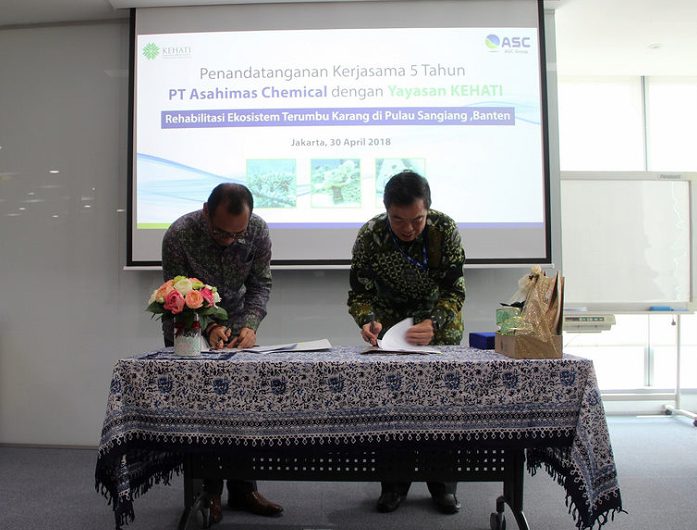Saving the Ecosystem of Sangiang Island, KEHATI And PT Asahimas Chemical Join Cooperation

-
Date:
30 Apr 2020 -
Author:
KEHATI
DATE: May 24, 2018
AUTHOR: KEHATI
The Indonesian Biodiversity Foundation (KEHATI) and PT Asahimas Chemical signed a cooperation program on coral reef rehabilitation in Sangiang Island, Banten. Through this program, it is hoped that the coral reef ecosystem in the marine conservation area which is currently in a threatened condition due to industrial, tourism, reclamation and development activities in the coastal area, can be saved.
The signing of the collaboration was carried out at the 10th Floor World Trade Center (WTC) Building, Jakarta, Monday 30 April 2018. This was the second phase of the collaboration program between KEHATI and PT Asahimas Chemical, which has been known as a producer of PVC which is a safe plastic material for marine ecosystems. In addition, the signing of this cooperation is also part of the commemoration of 2018 Earth Day.
The Executive Director of the KEHATI Foundation, Riki Frindos, said that the collaboration aims to continue the coral rehabilitation program on Sangiang Island within the framework of the Save Our Small Islands (SOSIS) program initiated by KEHATI. The aim of the program is to save small islands in Indonesia.
“The signing of this cooperation agreement is also a form of PT Asahimas Chemical’s 5-year long-term commitment to the conservation of coral reef ecosystems on Sangiang Island, which is not far from the working area of PT Asahimas Chemical,” said Riki.
The coral reef ecosystem rehabilitation program on Sangiang Island, continued Riki, was carried out in response to the damage to the coral reef ecosystem on the island. Based on the results of a baseline survey of coral cover conducted by KEHATI and PT Asahimas Chemical on the island, it was found that there has been sedimentation, and garbage deposits at the bottom of the island’s waters caused by waste sedimentation and anchor disposal. In many locations hard corals are found dead and stressed. Presumably caused by coral bleaching due to the changing environment.
The results of the research also showed that the increase in marine tourism activities on the island, by utilizing the services of coral reef ecosystems and small islands has not been followed by awareness of tourism and tourism actors in maintaining existing ecosystems. Boat tours often throw anchors on reefs, and tourists have not implemented responsible tourism by not littering.
Transplants with PVC media
One of the strategies pursued by KEHATI together with PT Asahimas Chemical to improve the condition of the coral reef ecosystem is the installation of artificial reefs and coral reef transplants by utilizing PVC pipe media. Artificial reefs provide a stable medium for coral reefs. Based on field observations, coral colonies found to begin to grow over the substrate. This is a sign that the coral colony is beginning to adapt to the new planting media.
“Coral transplantation can provide ecological niches for other marine life. Therefore, artificial reefs and coral reef transplants can be used as one the method of improving coral reef ecosystems on Sangiang Island,” he said.
The coral reef rehabilitation program on Sangiang Island which was conducted in 2016-2017 using PVC media provide a success story. Hard coral fragments transplanted in PVC-made media can adapt, survive, and have some growth. There is a significant growth, along with success in restoring ecosystems in the area.
“The results of this research provide a positive signal to broaden the program in the term of the intervention area and the involvement of other stakeholders, especially local fishing groups as important stakeholders,” Riki added.
Community Involvement
In this second phase of cooperation, the implementation of the propagation and transplantation method of coral reefs using a PVC module substrate will be expanded at two additional locations. Beside, on this state we will also encourage community involvement in the conservation of coral reef and island ecosystems, including training in diving tours and monitoring of coral reefs, as well as increasing the capacity and role of fishing boat charters in the conservation of the area and its utilization.
Community involvement in conservation activities is a key factor in the success of the program. If community groups are empowered, aware and benefit from these conservation activities, then eventually they will be able to independently manage it sustainably and improve welfare not only in the economic aspect but also on the social aspect.
“The revitalization of coral reefs on Sangiang Island is also an ecological control for industry players who have direct contact with the sea. If the waste management is not good, it will have an impact on the marine ecosystem or the revitalization of the coral reef that is bein
